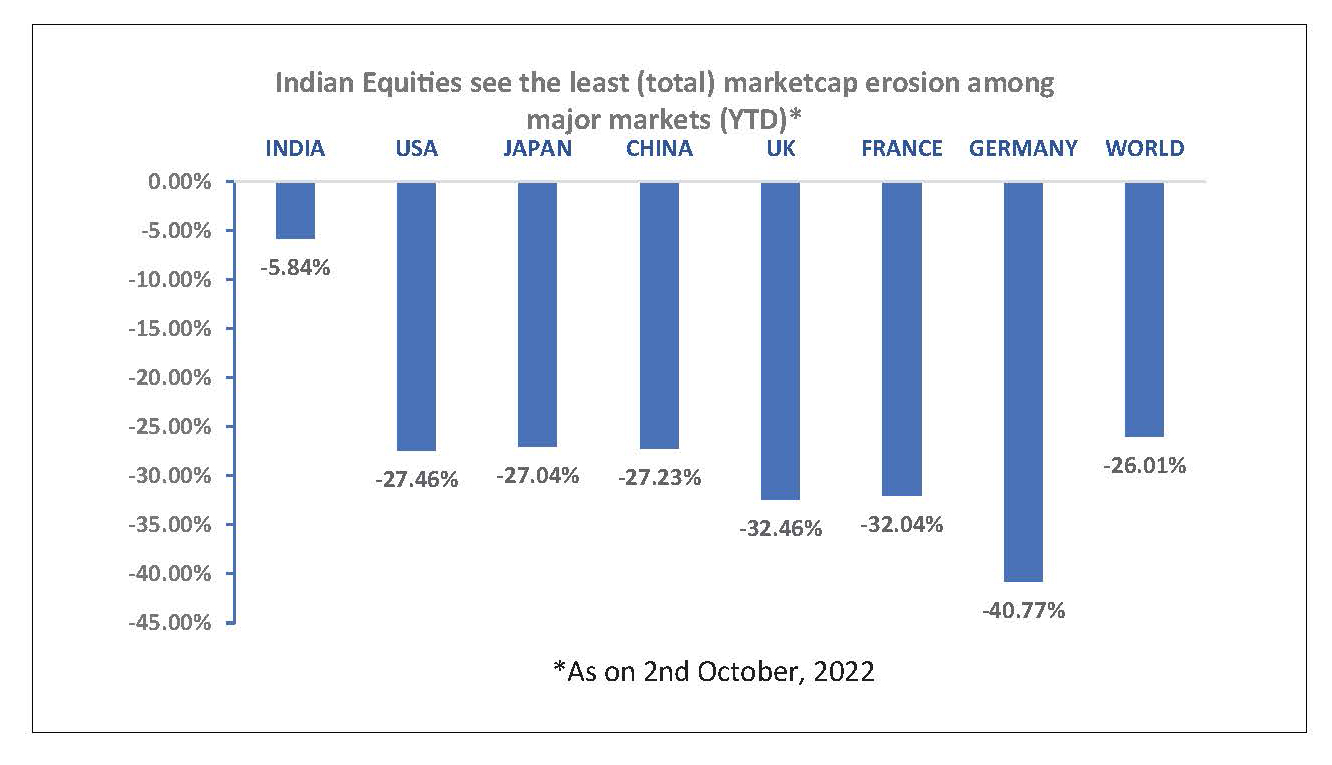
Macro and
Equity Market
Outlook
Equity Market
Outlook
Global Macro & Markets - Sep 2022
Indian markets fell in September, in line with major global markets,
as concerns over global growth slowdown and inflationary risk
prevailed. Major indices broadly fell over the month, with the Hang
Seng index (-13.7%), the MSCI World (-9.5%), the MSCI EM (-11.9%)
leading the fall. The S&P500 (-9.3%), the Euro 50 (-5.7%) and the
Nikkei (-7.7%) witnessed sharp falls as well. Additionally, NIFTY 50
India, and MOEX Russia fell -3.7% and -18.4% MoM, while BOVESPA
Brazil remained broadly flat over the same period, rising by +0.5%.
LME Metals Index witnessed a fall of -5.3% MoM owing to a
broad-based softening of demand, production ramp up in China
and a stronger dollar. Brent crude dropped 8.8% MoM as well. Dollar
index gained 3.1% over the month. US, India, and Germany 10 year
G-Sec rates were up by 64, 21 and 54 bps MoM and settled at 3.83%,
7.40% and 2.11% respectively.
Domestic Macro & Markets - Sep 2022
SENSEX fell -3.5% in September Mid-cap and small-cap indices
outperformed large-cap and were down 2.2% and 0.7%
respectively. On the sectoral front, all sectors delivered negative
returns, except for Pharma and FMCG Indices, with Power, Oil and
Gas, and Realty Indices falling by roughly 9% each. Market breadth
improved over the month with 56% of NIFTY 50 stocks trading
above their respective 200-day moving averages. FIIs were net
sellers in September, with FPI inflows ending after a two-month
streak. FPIs sold US$1.4 bn (till September 29) worth of Indian
equities in the secondary market, while DIIs bought US$1.7 bn (till
September 30).

India's high frequency data update:
Sustained high GST collections, solid core, manufacturing sectors
and agricultural sector outputs, accelerating credit growth &
moderating inflation bode well for the Indian economy.
Manufacturing PMI:
Manufacturing PMI fell MoM in September’22, reaching 55.1, to a
3-month low, but remained in expansion (>50 points) for the 15th
straight month, with a moderated increase in new orders and
output.
GST Collection:
INR 1.47 Tn (+26% YoY) in September’22 recorded the seventh
consecutive month of collections over 1.4Tn mark, with improving
tax compliance and healthy festive season economic activity
driving the sustained and rising collections.
Core sector production:
Core sector production contracted to a 9-month low of +3.3% YoY
in August’22, owing to a higher base and a deceleration in output
growth of steel, coal and electricity.
Industrial Production:
Manufacturing IIP moderated to a four-month low of a 2.4% YoY rise
in July’22 vs a 12.3% rise in June’22, after normalisation of a
favourable base effect, slowing export demand and heavy
monsoon downpour in select regions hit output.
Credit growth:
Credit growth accelerated to 15.01% YoY as of 9-September 2022
against YoY growth of 6.71% as observed on 10-September 2021.
Inflation:
CPI inflation in August’22 inched up marginally to 7% from 6.71% in
July’22 led by adverse supply shocks and heightened global
tensions. WPI inflation in August’22 fell 152bps MoM to 12.41%.
Trade Deficit:
Indian imports in September’22 grew 5.4% YoY to $59.4 Bn, while
Exports fell -3.5%yoy to $32.6 Bn, similar to last year’s export levels.
Trade Deficit for September’22 stood at $26.7 Bn, marginally lower
than August’22 level.
RBI:
The MPC met in September’22 (28th to 30th) and decided to
increase the policy repo rate under the liquidity adjustment facility
(LAF) by 50 basis points to 5.90% with immediate effect, as it
maintained its stance of 'withdrawal of accommodation’.
Consequently, the standing deposit facility (SDF) rate stands
adjusted to 5.65% and the marginal standing facility (MSF) rate and
the Bank Rate to 6.1%. These rate hikes were set in accordance with
the objective of achieving the medium-term target for consumer
price index (CPI) inflation of 4 per cent within a band of +/- 2 per
cent, while supporting growth. The RBI aims to pre-empt second
round effects of inflation and keep inflation expectations anchored,
with a view that this may support medium-term economic growth.
Market View
Risk-off sentiment prevails globally as Central Banks continue to
hike interest rates to tame inflation. Global growth concerns have
led to cool off in the commodity prices including crude, which
bodes well for India. We believe that inflation may have peaked out
and may gradually come down.
Domestic high frequency indicators remained resilient despite the
global headwinds underlining the domestic recovery possibilities.
Policy reforms, huge under investments in Capex, stronger
corporate Balance Sheets alongside a transition to a multipolar
world may aid manufacturing, exports and capex - creating a
virtuous cycle of growth. However, the near-term market sentiment
could be potentially impacted by headwinds like global slowdown,
especially in Europe, US and China along with higher interest rates,
higher energy costs, etc.
After the recent sharp rally in equities, the market has rerated and
may track pace of earnings recovery as multiple rerating has
already happened.
We are attempting to maintain balanced portfolios through a
combination of domestic recovery themes along with secular
businesses. The attempt is to identify relatively better valued
opportunities across these themes.
From an investor’s perspective given the external risks and its
potential impact investing in a staggered manner or systematic
route may help iron out market extremes. Given our view that
broader markets can do well with the present fundamentals,
long-term investors can consider diversified strategies like
multi-cap or flexi-cap offerings for pure equity investments.
Conservative investors seeking equity exposure with lower volatility
may consider asset allocation strategies like - Balanced
Advantage/Asset Allocator which manage equity allocations
dynamically.
Note:The sectors mentioned are not a recommendation to buy/sell in the said sectors.
The schemes may or may not have future
position in the said sectors. For complete details on Holdings & Sectors of NIMF schemes, please visit
website mf.nipponindiaim.com.
Past performance may or may not be sustained in future
Past performance may or may not be sustained in future
Chart of the month :
Indian Equities outperformed global peers (Year to Date) on better
growth inflation trade-off.

Common Source:
Nippon India Mutual Fund Research, Bloomberg
Disclaimer:The information herein above is meant only for general reading purposes and
the views being expressed only
constitute opinions and therefore cannot be considered as guidelines, recommendations or as a
professional guide for
the readers. The document has been prepared on the basis of publicly available information, internally
developed data
and other sources believed to be reliable. The sponsors, the Investment Manager, the Trustee or any of
their directors,
employees, Associates or representatives (‘entities & their Associate”) do not assume any responsibility
for, or warrant the
accuracy, completeness, adequacy and reliability of such information. Recipients of this information are
advised to rely on
their own analysis, interpretations & investigations. Readers are also advised to seek independent
professional advice in
order to arrive at an informed investment decision. Entities & their associates including persons
involved in the preparation
or issuance of this material, shall not be liable in any way for any direct, indirect, special,
incidental, consequential, punitive
or exemplary damages, including on account of lost profits arising from the information contained in
this material.
Recipient alone shall be fully responsible for any decision taken on the basis of this document.
